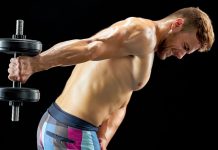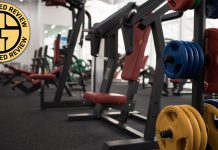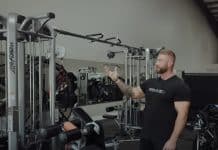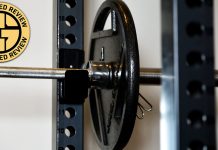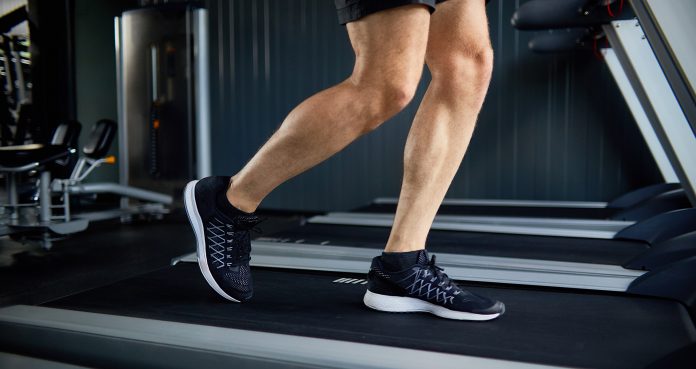
B-stance deadlifts improve your functional fitness.
The deadlift is an exceptional exercise that targets the muscles in your posterior chain (1). Nevertheless, it’s not as functional as single-limb movement due to its bilateral nature. In contrast, many daily activities involve unilateral movement, such as walking, kicking, or running with one leg at a time. As an alternative, B-stance deadlifts and single-leg deadlifts address this specific need.
The B-stance deadlift is slightly less stressful than the single-leg deadlift, especially regarding balance. However, this exercise is invaluable because it also takes all the benefits of the regular deadlift and channels it through your muscles one leg at a time. It’s the perfect middle ground between bilateral and unilateral exercises.
In movement, B-stance deadlifts closely resemble the Romanian deadlift. You can use either barbells, dumbbells, or kettlebells to do this routine. In this exercise guide, we look at how to do the B-stance deadlift, the benefits of this exercise, and other B-stance exercises that are great for your posterior chain muscles.
Techniques & Muscles Worked
B-stance deadlifts work on the muscles in your arms, legs, back, and core. These include the quads, hamstrings, glutes, abs, erector spinae, obliques, forearm flexors, and calves. The B-stance deadlift is a great way to improve your coordination and stability.
When doing a B-stance deadlift, it’s essential to use the proper form to maximize your gains. You should also use a weight that allows you to stay stable and in control. Below is a step-by-step guide for doing B-stance deadlifts with a barbell.
- Stand behind a barbell with your feet shoulder-width apart.
- Next, move one foot just behind the other. The ball of your back foot should be just behind the heel of your front foot.
- Hinge at your hips to squat down, then grab the barbell using a mixed or an overhand grip. Your hips should be just below your shoulders. This is your starting position.
- Lift your chest, brace your core, and put your shoulders down and back. Then, keeping the weight on your front foot, drive it to the floor to stand up.
- Your back leg should only be for assistance, while your arms should remain straight as you lift.
- Lower the barbell back to the floor to return to the starting position to complete the rep. Ensure that your back stays neutral throughout the movement.
- Repeat for as many reps as you desire.
- Swap legs and repeat steps 1-7.
Benefits
B-stance deadlifts offer many benefits as the bridge between the regular and single-leg deadlifts. They don’t overload your spine, and can help prevent injury compared to other moves that compress your spine more like barbell squats. Below are more benefits of the B-stance deadlift.
Build Posterior Chain Muscles
B-stance deadlifts target and build the muscles in your posterior chain, just like the regular deadlift. As a result, many people use it as an accessory exercise to regular deadlifts. The B-stance deadlift is great for the hamstrings, quads, and glutes.
Less Balancing Required
As the bridge between regular and single-leg deadlifts, the B-stance deadlift requires less balancing. This allows you to focus on the exercise and improve your mind-muscle connection. You can also lift heavier with the B-stance deadlift, leading to more muscle hypertrophy.
Good For Strength
B-stance deadlifts challenge your muscles to work hard because the load is mostly on one leg. Over time, this will lead to more stability and better strength gains. Research also shows that unilateral exercises produce strength gains in both limbs even when the second one is not used (2).
Better Hip & Trunk Stability
When standing on one leg, you engage your hips better. In addition, your core muscles will have to work harder to keep you steady. Over time, doing B-stance deadlifts will improve your hip and trunk stability.
Good for Posture
When B-stance deadlifts engage your core and hip, they indirectly strengthen your spine. The spine is crucial in maintaining proper posture and alignment. Thus, the B-stance deadlift helps to improve your posture.
Progression for Single-leg Deadlifts
The single-leg deadlift, while helpful, requires a lot of balancing. Going straight from regular deadlifts to the single-leg variation could prove challenging for many people, as the stability required is too much. B-stance deadlifts are a midway point that you can use to strengthen your muscles before progressing to the single-leg deadlift.
Find & Fix Muscle Imbalances
While not entirely unilateral, the B-stance deadlift focuses on one leg more than the other. This can help you find and fix any muscle imbalances between both legs. All you have to do is pay attention to which leg needs more work and apply that accordingly.
B-stance Deadlifts Alternatives
The B-stance deadlift is an excellent way to do deadlifts unilaterally with some support that reduces the required balancing. However, there are lots of B-stance exercises that also offer the same. Below are some of them that you should consider.
B-Stance Romanian Deadlift
B-stance Romanian deadlifts also work on your posterior chain muscles. However, with this exercise, you may not be able to lift as much as the B-stance deadlift. That being said, this is a much easier alternative to the single-leg RDL for balancing.
B-Stance Lunge
The B-stance lunge is excellent for your legs and works on your hamstrings, glutes, calves, and quads. For the B-stance lunge, your feet will be closer than with the traditional lunge. This routine also requires more stability.
B-Stance Hip Thrust
The B-stance hip thrust can help you properly target and work on your hamstrings and glutes. This exercise works the same muscles as the B-stance deadlift but is less balance-intensive. This makes it an excellent alternative for beginners.
FAQs
What does B stance deadlift work?
The B-stance deadlift works on the muscles in your legs, core, back, and arms. However, it specifically focuses on your posterior chain muscles. This exercise is a great variation of the barbell deadlift and allows you to do it unilaterally.
What is the difference between a B stance and a split stance?
With a B-stance, you have one foot in front of the other, with your back foot just slightly behind the front foot. On the other hand, the split stance has your legs a bit more apart.
How do you get into a B stance?
To achieve the B-stance, first, you stand with your feet shoulder-width distance apart. Then, you put one foot in front of the other with the ball of your back foot just behind the heel of the front foot. For more information, especially on how to do a B-stance deadlift, check the exercise guide above.
Follow us on Instagram, Facebook, and Twitter for more exercise guides!
References
- Martín-Fuentes, I., Oliva-Lozano, J. M., & Muyor, J. M. (2020). Electromyographic activity in deadlift exercise and its variants. A systematic review. PloS one, 15(2), e0229507. https://doi.org/10.1371/journal.pone.0229507
- Green, L. A., & Gabriel, D. A. (2018). The cross education of strength and skill following unilateral strength training in the upper and lower limbs. Journal of neurophysiology, 120(2), 468–479. https://doi.org/10.1152/jn.00116.2018



